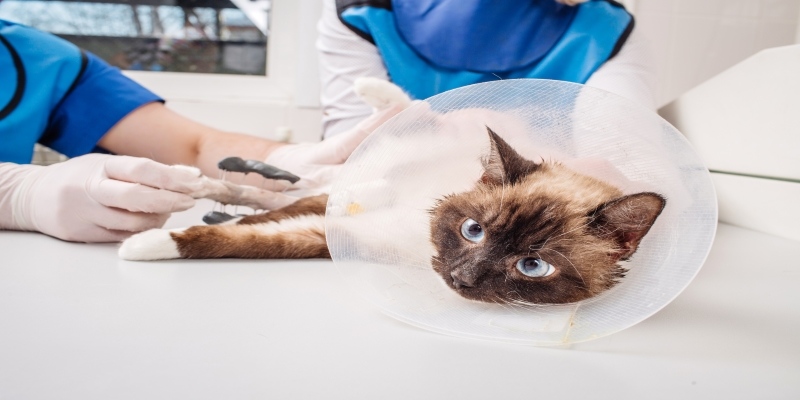Decoding Pet Insurance: Navigating the Terrain of Pre-Existing Conditions
Jan 18, 2024 By Triston Martin
Pet insurance simplifies pet healthcare payments, covering costs like accidental injuries, illnesses, and medications. While it eases financial burdens for pet owners, it's not all-encompassing. Some insurers exclude pre-existing conditions, although coverage varies among insurance providers.
Top of Form
Pets are cherished family members, bringing joy, companionship, and, sometimes, unexpected veterinary expenses. A common question arises in pet insurance: does it cover pre-existing conditions? Let's embark on a journey to demystify this aspect of pet insurance and equip pet owners with the knowledge they need to make informed decisions about their furry friend's well-being.
Understanding Pet Insurance Basics:
Before we dive into pre-existing conditions, let's get the basics of pet insurance. It's like a safety net for your furry friend's medical expenses—accidents, illnesses, and preventive care. Pet plans differ, providing various coverage levels and terms like our health insurance.
Picture it as a menu with options; you choose what suits your pet's needs. From routine check-ups to unexpected mishaps, pet insurance is your go-to for keeping your pet healthy without breaking the bank. Understanding these basics sets the stage for uncovering whether those pesky pre-existing conditions cut through your pet's coverage.
There are three coverage tiers for pet insurance, which consist of:
- Accident-only: The least comprehensive coverage available to pet owners is accident-only. It might only be able to pay for the expenses of treating illnesses or poisonings that result from accidents.
- Comprehensive coverage: The costs and conditions associated with medical care are covered by comprehensive pet insurance. For example, if you have a comprehensive plan, you might be covered for lab costs or X-rays.
- Wellness: Preventive care, including physical examinations, flea and heartworm treatments, and vaccinations, is usually covered under wellness insurance.
What Constitutes a Pre-Existing Condition in Pets?
A pre-existing condition in pets means any illness or injury your pet has before getting insurance. It could be a long-term issue like diabetes or allergies or a one-time injury like a broken bone. These conditions already exist before coverage starts and might be tricky to get covered.
Curable and Incurable Pre-Existing Conditions
Regarding pre-existing conditions in pets, they can be broadly categorized into curable and incurable conditions.
Curable Pre-Existing Conditions
Curable pre-existing pet conditions, like infections or injuries, can be effectively managed with proper care. Although existing before insurance, they may be covered after a waiting period, as they're manageable.
Incurable Pre-Existing Conditions
Incurable pre-existing pet conditions, such as chronic diseases or permanent injuries, cannot be completely cured. They demand continuous treatment and care throughout a pet's life, presenting challenges in obtaining coverage.
Navigating the complications of pet insurance requires understanding the differences between curable and incurable pre-existing diseases in pets. To protect their furry friends, pet owners should proactively educate themselves on policy terms, investigate coverage possibilities, and obtain insurance as soon as possible.

Does Pet Insurance Typically Cover Pre-Existing Conditions?
The straightforward answer is no; most pet insurance policies do not cover pre-existing conditions. Insurance providers consider these conditions as existing risks, and protecting them could lead to adverse selection, where pet owners only seek coverage for known issues. This would undermine the financial sustainability of insurance plans.
Exceptions and Variances in Coverage:
While the general rule is that pre-existing conditions are excluded from coverage, there are exceptions and variances among pet insurance providers. Some insurers may cover certain pre-existing conditions if the pet has been symptom-free and treatment-free for a specified waiting period. Pet owners must thoroughly review policy terms and conditions to understand coverage specifics.
The Importance of Early Coverage:
Pet owners are encouraged to obtain insurance coverage early in their pets' lives to avoid potential complications with pre-existing conditions. Insuring a pet when they are young and healthy increases the likelihood of comprehensive coverage for future illnesses or injuries that may arise. Waiting until a pet develops health issues could limit the scope of coverage.
Navigating Waiting Periods:
Pet insurance policies often include waiting periods before coverage becomes effective. During this time, certain conditions may not be covered. Understanding the waiting period is crucial for pet owners to manage expectations and plan for potential out-of-pocket expenses during the initial stages of coverage.
Options for Pets with Pre-Existing Conditions
For pet owners whose furry companions already have pre-existing conditions, all hope is not lost. Some specialized pet insurance providers offer coverage options for pets with existing health issues. While these policies may have limitations and higher premiums, they provide a valuable alternative for ensuring financial assistance in managing ongoing health concerns.
Considering Alternative Financial Strategies:
Pet owners can explore alternative financial strategies when obtaining pet insurance coverage for pre-existing conditions proves challenging or expensive. Creating a dedicated savings fund for veterinary expenses, researching local veterinary clinics with affordable services, or considering nonprofit organizations that offer financial assistance can be viable options.
The Role of Regular Check-ups and Preventive Care:
Preventive treatment and routine veterinarian check-ups are essential to preserving a pet's health, regardless of pre-existing illnesses. Frequent examinations can help identify potential issues early on, allowing for proactive management and perhaps reducing the long-term impact of pre-existing conditions.

The Botcheck-ups!
In conclusion, Navigating pet insurance and pre-existing conditions demands a grasp of policy terms, waiting periods, and alternative options. Pet owners should educate themselves on their insurance plan, considering early coverage for optimal benefits. Despite challenges with pre-existing conditions, informed decisions and proactive healthcare contribute to pet well-being.
Responsible pet care involves prevention, financial planning, and understanding insurance complexities. Decoding coverage intricacies empower owners to offer the best life for pets, ensuring their health and happiness are supported with confidence and care.

2024 biBERK Business Insurance: Assessing the Pros and Cons
Jan 29, 2024
Review and analysis of biBERK Business Insurance: its benefits, drawbacks, industries covered, and customer feedback. Ideal for small to medium-sized businesses.

Secured Personal Loans
Jan 13, 2024
Personal loans enable you to borrow money based on the value of an item you already own, such as a vehicle or savings. There is a tradeoff between the potential for lower interest rates and the inherent hazards associated with secured loans.

Exploring 6 Alternatives for Quicken Business Loan
Mar 20, 2024
Discover quick alternatives to traditional business loans with this comprehensive guide on Quicken business loan alternatives.

Partnership vs. Corporation - A Simple Guide
Jan 25, 2024
Let’s discuss the differences between business and personal checking accounts with our comprehensive guide. Understand the key distinctions in features, benefits, and requirements.

What is a Taxable Account
Jan 31, 2024
Interested in opening a taxable account? Learn more about the types of contributions allowed, their benefits for short-term and long-term goals, and other tips.

Are Business Credit Cards Eligible for Credit Card Hardship Programs?
Feb 23, 2024
Most credit card hardship programs target individuals instead of company accounts. Alternative solutions are available from the respective credit card issuer.

RealCrowd Online Investment Platform Review 2024
Mar 14, 2024
In this article, discover the latest insights into RealCrowd Online Investment Platform in 2024.

Making the Right Choice: How to Pick the Perfect Bank for Your Financial Needs
Mar 19, 2024
Discover how to select the perfect bank for your financial needs with our comprehensive guide, covering bank types, essential factors to consider, and comparison strategies.

Ways Marginal Revenue Related Marginal Cost Production
Feb 11, 2024
Marginal cost of production and the marginal revenue are economic metrics that are used to calculate the quantity of output and the price per unit of a product that will result in the greatest amount of profits.

College Students' Guide to the Best Part-Time Jobs
Oct 01, 2023
If you're a student looking for a part-time job that's handy, flexible, and lucrative, these are the most acceptable options. If you're looking for a part-time job to help pay for school, keep your class schedule and relevant work experience in mind. As a college student, you need a part-time job that is easy to get to and doesn't interfere with your ability to keep an excellent academic record.

What Is a Conduit IRA? Everything You Need To Know
Feb 25, 2024
A conduit IRA is a type of account that allows you to roll over funds from a qualified retirement plan. You can then transfer the money into another qualified retirement plan in the future. If you consider using a conduit IRA, you should be aware of some of the benefits and risks involved

How Many Hours a Week is Part-Time?
Feb 14, 2024
Deciding on the right amount of hours to work part-time? Learn more about what typical part-time schedules include, their pros and cons, and whether it's the best fit for you.